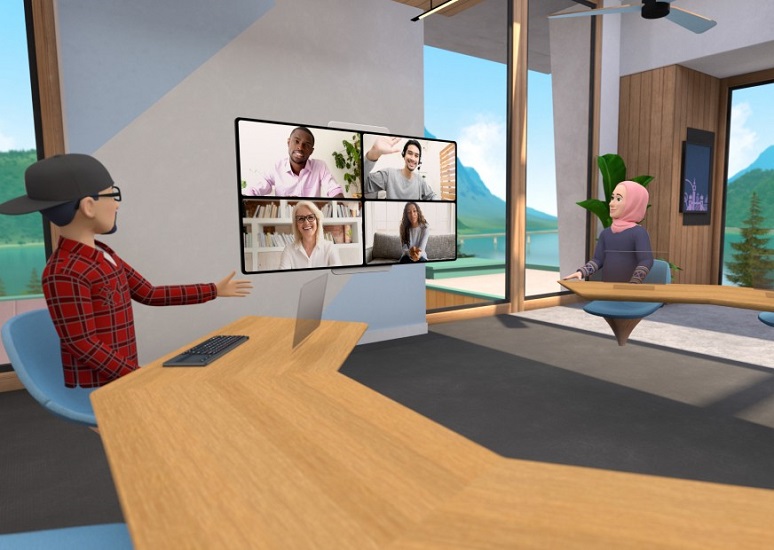This article appeared originally on our sister site, No Jitter
Facebook CEO Mark Zuckerberg has made it no secret that Facebook’s future is in the metaverse. On an
earnings call in July, he stated: “In addition to being the next generation of the Internet, the metaverse is also going to be the next chapter for us as a company. And in coming years, I expect people will transition from seeing us primarily as a social media company to seeing us as a metaverse company.”
This prompted a lot of buzz on the Internet, as reaction ranged from “what is the metaverse” to “is this something we really want Facebook to do?” As I've
written previously, I discussed the importance of virtual reality (VR) as a collaboration tool in the workplace and why I believe it is becoming a vital part of communications technology. So, I was very interested in this announcement as this move validates the notion that the trend of using VR for work is indeed real and gaining momentum.
Still, I was surprised to see the announcement last week that Facebook was launching Horizon Workrooms, a VR application for remote collaboration. Additionally, a beta version of Workrooms was made available for download in the Oculus store.
I knew this was coming eventually, but the timing is interesting. Workrooms is based on the Horizon platform, which is still in very limited invitation-only beta testing. This announcement also comes two months before Facebook Connect, where Facebook typically announces new VR and AR solutions. It also signals to the world that Facebook’s strategy around VR and augmented reality (AR) is not just about consumer products but embraces the concept of the metaverse as somewhere we both play and work.
What is Workrooms?
Workrooms is a 3-D virtual office you can access with an Oculus VR headset. It is made up of several components that replicate activities you would do in an actual office and allows for multiple participants to join via VR or video. Below I explore four highlights from my first impressions of using Workrooms.
1. Virtual desk – Workrooms is intended to be used while sitting at a physical desk. Using cameras on the Oculus headset, you map out where your desk is so that the virtual desk matches your actual desk. With compatible keyboards, the headset can replicate your physical keyboard in the virtual world while showing the position of your hands and fingers. With a wireless link to your computer, you can bring up your computer desktop into the virtual office with full mouse and keyboard support.
I know this sounds confusing, but it solves the problem of not having access to your computer while wearing a VR headset. The concept here is that you can access your desktop in VR with unlimited screens of unlimited size, all while blocking out visual distractions wherever you are. VR applications exist that already do this, but most aren’t centered around collaboration.
2. Collaboration – A significant Workrooms feature is the ability to invite team members to join the virtual office either through VR headsets or through a web browser. Remote attendees joining via VR will appear sitting at the table as a user-customized avatar. Non-VR attendees can join via web browser by simply clicking on the provided link and appear as video participants on a screen in the virtual space. This is huge — most VR collaboration platforms don’t allow users to join without a headset. Or if they can, it usually requires an application and a login. Being able to integrate non-VR users easily into the space is perhaps its greatest feature.
The biggest obstacle for VR adoption is getting users to make the leap into VR in the first place. By supporting web-based views into VR spaces, casual users can get a glimpse of the power of VR and will likely be encouraged to go further. For many people, 2-D PC views into VR are the gateway to buying a headset. I know that was the case for me – I joined several meetings in AltspaceVR on my computer and was inspired to buy a headset to make the experience more immersive.
3. Whiteboard – The whiteboard feature allows you to stand up to a virtual whiteboard and draw while holding the Oculus controller like a pen. This works surprisingly well and is one of the better whiteboard experiences I’ve used, outside of the expensive hardware-based solutions. Whiteboarding is something that is part of most in-person meetings, but video meetings mostly leave it out. Most online meeting tools have some whiteboard support, but it is rarely used. The Workrooms implementation of this needed feature is very innovative and gives us a glimpse into the future of spinning up a whiteboard wherever we want.
4. Team collaboration space – In addition to the team meeting spaces, a dedicated team collaboration web page is linked to the space, allowing team members to post documents, chat, schedule meetings, and task lists during and outside of meetings. I’ve found that the lack of connection outside of other VR collaboration applications is a hugely limiting factor to their use. This also shows VR isn’t a replacement to team collaboration tools but is an integrated component for facilitating live interactions.
Workrooms has its problems, limitations, and a lot of room for improvement and expansion. But even as a beta version, it is a huge step forward for workplace VR. The ultimate user adoption will depend on future enhancements and improvements in VR headset technology. Being able to marry headset technology with application development puts Facebook at a huge advantage, as they can build the Oculus hardware (which they own) to match their VR platforms and vice versa.
I’ll be sharing more at the upcoming Enterprise Connect 2021 event, taking place Sept. 27-29, in Orlando, Fla. In my session, “
Virtual/Augmented Reality: The Shape of Collaboration to Come?," I'll be exploring VR and AR and how both are reshaping all facets of how we communicate and work. If you'd like to attend, use the promo code
WSCAL200 to save $200 off the current rate.






